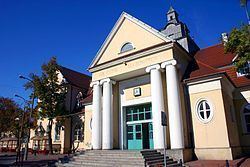Time zone CET (UTC+1) Area 13.19 km² | Town rights 1522 Postal code 05-825 to 05-827 Population 27,055 (2006) Local time Friday 6:08 PM | |
 | ||
County Grodzisk Mazowiecki County Weather 6°C, Wind W at 5 km/h, 74% Humidity | ||
Eric moore drum clinic 2014 grodzisk mazowiecki
Grodzisk Mazowiecki [ˈɡrɔd͡ʑisk mazɔˈvʲɛt͡skʲi] is a town in central Poland with 29,363 inhabitants (2011). It is 30 km. southwest of Warsaw. Between 1975 and 1998 it was situated in the Warszawa Voivodeship but since 1999 it has been situated in the Masovian Voivodeship. It is the capital of Grodzisk Mazowiecki County.
Contents
- Eric moore drum clinic 2014 grodzisk mazowiecki
- Map of Grodzisk Mazowiecki Poland
- Global sound in grodzisk mazowiecki poland 20 of july 2013
- History
- Geographic and administrative location
- Legends
- Jewish community
- Tourist attractions
- Recreational areas
- Sister cities
- References
Map of Grodzisk Mazowiecki, Poland
Global sound in grodzisk mazowiecki poland 20 of july 2013
History
The origins of Grodzisk Mazowiecki can be traced back to the 12th century when medieval village Grodzisk was created. This settlement was built on the outskirts of the Jaktorowska Forest and the its remains are a part of the existing town area. In 1355 the first known owner of the settlement Tomasz Grodzinski founded a church which was later destroyed by fire (1441). In 15th century Grodzisk remained the parish seat. Dating from the end of the 15th century to 1623 the village was owned by Okunia family and the Mokrowski family. In 1522 Grodzisk Mazowiecki has received Municipal Rights from king Zygmunt (Sigismund) I Old. In 1540 Grodzisk was destroyed by the fire and wasn’t reconstructed until the end of 16th century. After the reconstruction, Grodzisk Mazowiecki became a local trade and production centre due to its location and the local traffic routes. In 1655 it was again destroyed during Swedish Deluge and then restored. In 1708 the town was struck by a cholera epidemic and as a result its population diminished down to 370 people. During the November Uprising (1830-1831) the town was the place of fights between the insurrectionists’ forces and Russian army. The recovery of the local economy was possible to the prosperous railway route connecting Warsaw and Skierniewice built in 1846. In 1870 the town’s municipal rights were taken away. Between the 19th and 20th century Grodzisk was known as recreation center with hydropatic establishment founded by Michał Bojasiński. In 1915 Grodzisk recaptured its municipal rights Currently, Grodzisk Mazowiecki is a local industrial center for the area of Warsaw.
During World War II, a Roman Catholic farmer, Stanislawa Slawinska, hid Jews from the Nazis in her house in Grodzisk Mazowiecki. In 2008, she was honoured as Righteous Among the Nations by Yad Vashem. One of her Jews she saved was the mother of Israeli businessman Yossi Maiman.
Geographic and administrative location
Legends
According to this legend, monarchs were riding through the settlement Grodzisk on their way to haunting in Jaktorowska forest. One of the monarchs who was tired was offered a cup of water from the town’s spring to regain his strengths. It was the extraordinary taste of the water that convinced the king to grant the town a charter.
Jewish community
The town had a Jewish community and it had been the center of the Hasidic Grodzhisk dynasty, (Grodzisk Mazowiecki being pronounced as "Grodzhisk" in Yiddish.) Grodzisk was the birthplace of Kalonymus Kalman Shapira (1889-1943), also known as the Rebbe of the Warsaw Ghetto. During the wartime all the Jewish population was deported and murdered.
In 2016, the remains of the Jewish cemetery in town were saved from being developed into a residential complex, and the city council pledged to preserve the cemetery, restore the original gate with Hebrew inscription, and build a fence around the property. Plans to build the residential complex were originally halted in 2014 when residents of the nearby Jewish community of Warsaw, as well as activist Robert Augustyniak, protested the plan.
Tourist attractions
was built in 1845 in a shape of a small locomotive. It was built right after launching the first part of the Warsaw- Vienna railway. The building is situated next to the old railway station.
was established in 1687. In the church there are numerous examples of sacred paintings from the 18th century.
was established in the 18th century.
was built in 1713 as a gesture of gratitude for the end of cholera epidemic. In 1995 the Chapel was moved next to the St. Anne’s Church.
was constructed in the 18th century. It is an example of baroque architecture. Dating from 1869 it was the residence of the Skarbek family. Today, the building serves as a National Music School of the 1st degree.
